Ford Puma vs SEAT Leon – Which car suits you better?
Costs and Efficiency:
Price and efficiency are often the first things buyers look at. Here it becomes clear which model has the long-term edge – whether at the pump, the plug, or in purchase price.
SEAT Leon has a hardly perceptible advantage in terms of price – it starts at 24500 £, while the Ford Puma costs 24800 £. That’s a price difference of around 317 £.
Fuel consumption also shows a difference: SEAT Leon manages with 1.20 L and is therefore convincingly more efficient than the Ford Puma with 5.40 L. The difference is about 4.20 L per 100 km.
As for range, the Ford Puma performs clearly better – achieving up to 376 km, about 243 km more than the SEAT Leon.
Engine and Performance:
Power, torque and acceleration say a lot about how a car feels on the road. This is where you see which model delivers more driving dynamics.
When it comes to engine power, the SEAT Leon has a distinct edge – offering 272 HP compared to 168 HP. That’s roughly 104 HP more horsepower.
In acceleration from 0 to 100 km/h, the Ford Puma is barely noticeable quicker – completing the sprint in 7.40 s, while the SEAT Leon takes 7.70 s. That’s about 0.30 s faster.
In terms of top speed, the SEAT Leon performs barely noticeable better – reaching 220 km/h, while the Ford Puma tops out at 210 km/h. The difference is around 10 km/h.
There’s also a difference in torque: SEAT Leon pulls a bit stronger with 360 Nm compared to 290 Nm. That’s about 70 Nm difference.
Space and Everyday Use:
Cabin size, boot volume and payload all play a role in everyday practicality. Here, comfort and flexibility make the difference.
Both vehicles offer seating for 5 people.
In curb weight, Ford Puma is hardly perceptible lighter – 1316 kg compared to 1344 kg. The difference is around 28 kg.
In terms of boot space, the Ford Puma offers noticeable more room – 523 L compared to 380 L. That’s a difference of about 143 L.
In maximum load capacity, the SEAT Leon performs barely noticeable better – up to 1301 L, which is about 18 L more than the Ford Puma.
When it comes to payload, SEAT Leon hardly perceptible takes the win – 521 kg compared to 469 kg. That’s a difference of about 52 kg.
Who wins the race?
The SEAT Leon proves to be leaves the rival little chance and therefore becomes our DriveDuel Champion!
SEAT Leon is the better all-rounder in this comparison.
Costs and Consumption
View detailed analysis
Engine and Performance
View detailed analysis
Dimensions and Body
View detailed analysis
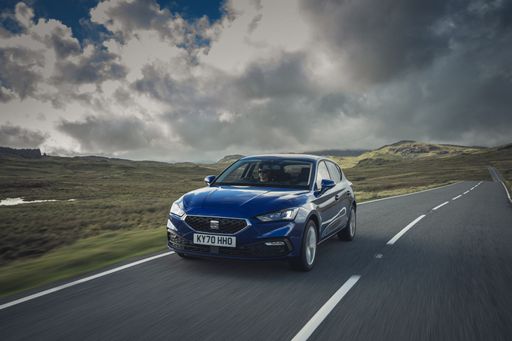 @ SEAT S.A. / SEAT Media Center
@ SEAT S.A. / SEAT Media Center
SEAT Leon
Ford Puma
The Ford Puma is a cheeky compact crossover that blends sporty styling with city-friendly practicality, giving drivers a surprisingly fun and composed ride. With clever storage tricks and a lively personality, it’s a smart pick for buyers who want enjoyment without fuss.
details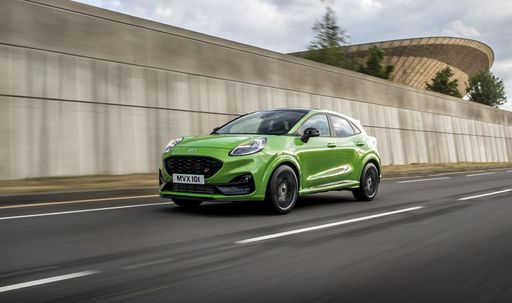 @ Ford Motor Company / Ford Media Center
@ Ford Motor Company / Ford Media Center
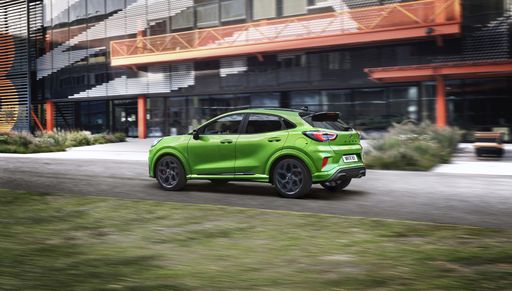 @ Ford Motor Company / Ford Media Center
@ Ford Motor Company / Ford Media Center
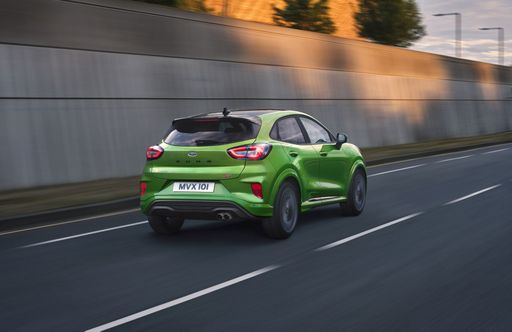 @ Ford Motor Company / Ford Media Center
@ Ford Motor Company / Ford Media Center
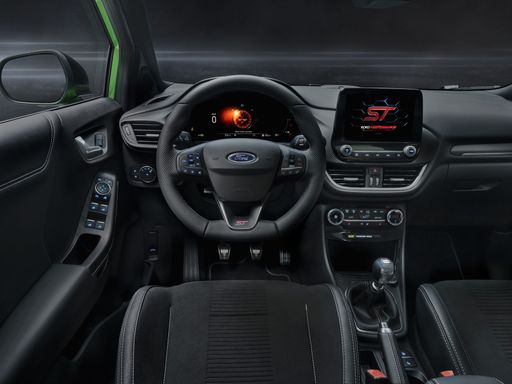 @ Ford Motor Company / Ford Media Center
@ Ford Motor Company / Ford Media Center
SEAT Leon
SEAT Leon pairs sharp, modern styling with a cabin that's sensible and slightly sporty, making it an appealing choice for buyers who want flair without fuss. It drives with eager composure and offers a neat balance of comfort and agility, so you get everyday usability with a wink of fun.
details @ SEAT S.A. / SEAT Media Center
@ SEAT S.A. / SEAT Media Center
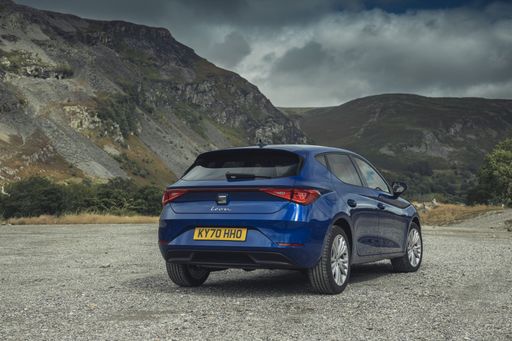 @ SEAT S.A. / SEAT Media Center
@ SEAT S.A. / SEAT Media Center
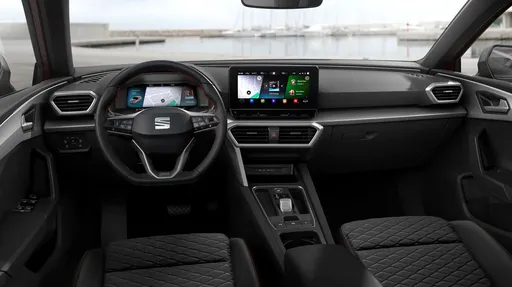 @ SEAT S.A. / SEAT Media Center
@ SEAT S.A. / SEAT Media Center
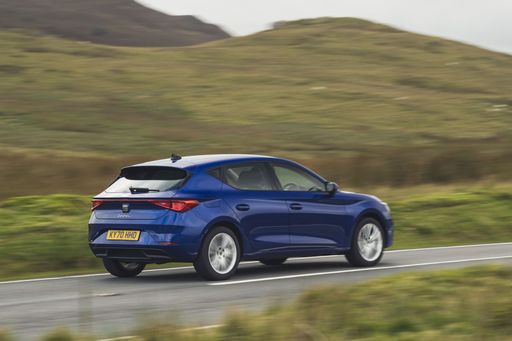 @ SEAT S.A. / SEAT Media Center
@ SEAT S.A. / SEAT Media Center
 @ Ford Motor Company / Ford Media Center
@ Ford Motor Company / Ford Media Center
|
 @ SEAT S.A. / SEAT Media Center
@ SEAT S.A. / SEAT Media Center
|
|
|
|
Costs and Consumption |
|
|---|---|
|
Price
24800 - 36300 £
|
Price
24500 - 36400 £
|
|
Consumption L/100km
5.4 - 5.9 L
|
Consumption L/100km
1.2 - 5.5 L
|
|
Consumption kWh/100km
13.1 - 13.9 kWh
|
Consumption kWh/100km
-
|
|
Electric Range
361 - 376 km
|
Electric Range
133 km
|
|
Battery Capacity
43 kWh
|
Battery Capacity
19.70 kWh
|
|
co2
0 - 135 g/km
|
co2
27 - 126 g/km
|
|
Fuel tank capacity
42 L
|
Fuel tank capacity
40 - 45 L
|
Dimensions and Body |
|
|---|---|
|
Body Type
SUV
|
Body Type
Hatchback
|
|
Seats
5
|
Seats
5
|
|
Doors
5
|
Doors
5
|
|
Curb weight
1316 - 1563 kg
|
Curb weight
1344 - 1657 kg
|
|
Trunk capacity
456 - 523 L
|
Trunk capacity
270 - 380 L
|
|
Length
4186 - 4226 mm
|
Length
4368 mm
|
|
Width
1805 mm
|
Width
1799 mm
|
|
Height
1550 - 1555 mm
|
Height
1442 - 1460 mm
|
|
Max trunk capacity
1216 - 1283 L
|
Max trunk capacity
1187 - 1301 L
|
|
Payload
367 - 469 kg
|
Payload
473 - 521 kg
|
Engine and Performance |
|
|---|---|
|
Engine Type
Electric, Petrol MHEV
|
Engine Type
Petrol, Petrol MHEV, Diesel, Plugin Hybrid
|
|
Transmission
Automatic, Manuel
|
Transmission
Manuel, Automatic
|
|
Transmission Detail
Reduction Gearbox, Manual Gearbox, Dual-Clutch Automatic
|
Transmission Detail
Manual Gearbox, Dual-Clutch Automatic
|
|
Drive Type
Front-Wheel Drive
|
Drive Type
Front-Wheel Drive
|
|
Power HP
125 - 168 HP
|
Power HP
116 - 272 HP
|
|
Acceleration 0-100km/h
7.4 - 9.8 s
|
Acceleration 0-100km/h
7.7 - 10.5 s
|
|
Max Speed
160 - 210 km/h
|
Max Speed
197 - 220 km/h
|
|
Torque
170 - 290 Nm
|
Torque
220 - 360 Nm
|
|
Number of Cylinders
3
|
Number of Cylinders
4
|
|
Power kW
92 - 124 kW
|
Power kW
85 - 200 kW
|
|
Engine capacity
999 cm3
|
Engine capacity
1498 - 1968 cm3
|
General |
|
|---|---|
|
Model Year
2025
|
Model Year
2024 - 2025
|
|
CO2 Efficiency Class
A, D
|
CO2 Efficiency Class
D, B
|
|
Brand
Ford
|
Brand
SEAT
|
Is the Ford Puma offered with different drivetrains?
The Ford Puma is offered with Front-Wheel Drive.
The prices and data displayed are estimates based on German list prices and may vary by country. This information is not legally binding.
